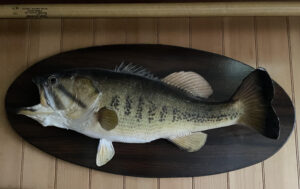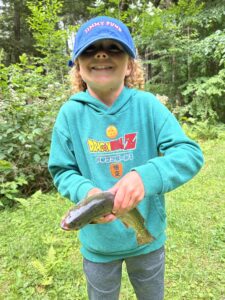Kudos to the Massachusetts Wildfire Crew
A crew of Massachusetts wildfire fighters recently returned from a 14-day assignment on the Flat Fire protecting values at risk in Pioneerville, Idaho. The crew included 18 members from the Department of Conservation and Recreation (DCR) and 3 members of the MassWildlife fire team. Two of the MassWildlife staff were from the Western District. Nate Buckhout (Western District Wildlife Biologist) and Heather Sadler (Western District Wildlife Technician) joined Benjamin Mazzei (Westboro Habitat Biologist) on the deployment.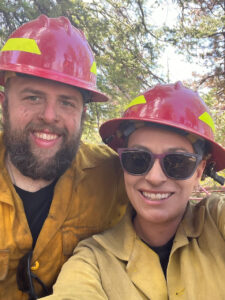
They left on August 11 and returned home on August 27. While there, they camped on a dirt airstrip in Idaho City (population of about 485), about 1 ½ hours north of Boise, Idaho. They slept right on the dirt runway.
There weren’t that many firefighters when they first arrived, but the number eventually grew to 350+ firefighters. The camp grew from a couple of tents to a point where there were caterers, a tractor trailer with 16 showers, a finance office, a medical logistics, etc. The temperatures were very hot (mid 90’s) but it cooled a little toward the end of the assignment.
The workdays were around 16 hours. They got up at 5:30 am, ate dinner around 10:00 pm and were in bed by 11:00 pm. One day they had to stay longer because the fire jumped over the fire line and they ended up fighting it in the dark.
It usually took one to 1 ½ hours to get to the fire because they had to travel very slowly on winding logging roads. Fortunately, no one in their group got injured. They had a good group of people who knew what they were dealing with and helped those that did not.
All the Massachusetts men and women firefighters worked as a Type 2 Initial Attack Team working with hand tools to build fire lines and contain active fires. The group broke into smaller squads to meet specific objectives depending on the day’s assignment.
“We got thrown into everything.” Said Buckhout. They were put into a spike camp (remote camp with less amenities). There they set up their tents while others drove food up from down below. At the spike camp, there was no cell service, no showers, and only a couple of bath rooms.
When they arrived the fire was less than 10% contained but when they left it was 60% controlled which was great because there were other big fires nearby blowing up. Their fire wasn’t a relatively big fire compared to others, but because of the location as to communities and type of areas it was a concern. It was maybe 3,800 acres at its largest, but there was a 40,000 acre fire north of them in an 80,000 acre wilderness area.
Other than the Massachusetts crew, there were no other firefighters there from the east. Most of the assisting firefighters came from Colorado, Wyoming, Utah or California. The Idaho warden who was in charge called them out and said that he would ask for them by name the next time. They left with a good impression with all the different divisions with whom they worked.
The smoke wasn’t great. The worst part was the dust, because it was so dry, and the altitude, hiking those hills. When you stepped anywhere, there was a cloud of dust. When driving, there was so much dust from the vehicle in front, they had to let it clear so that could see.
They felt like they were doing something that mattered. As much as it was realy tough, it was a great experience and they would do it again.
Being able to work with DCR they saw a different perspective. They were all just one, not DCR or DFW. It was a very positive experience working with DCR and they made good friends.
The assignment was particularly arduous, said MassWildlife District Manager Andrew Madden, but the crew gained valuable experience which will be applied to MassWildlife’s prescribed fire program.
It was a good year for land protection in the Western District
That’s according to Andrew Madden. He gave delegates the good news at the September meeting of the Berkshire County League of Sportsmen which was held on September 5 at the Lee Sportsmen’s Association..
During the period from July 2023 to June 2024 the following projects were completed:
Shales Brook Wildlife Management Area (WMA) – Becket – A 73-acre gift of land off Tyringham Road abutting the existing WMA.
Savoy WMA -Savoy – A 4-acre acquisition on Harrington Road surrounded by the existing WMA. The project improves access and prevents development which would reduce land available for hunting.
Green River WMA – Williamstown – 100 acres abutting the existing WMA. The property includes frontage along the green river and quality forest on the uplands.
Edge Hill Wildlife Conservation Easement (WCE) – Ashfield – This 132-acre Conservation Easement is held in partnership with the Franklin Land Trust. The property (a former golf course) is open to the public and available for hunting.
Hiram Fox WMA – A 50-acre forested inholding accessible from the existing WMA.
Karner Brook WMA – 18 acres with stream frontage that expands on the existing WMA.
Eugene Moran WMA – 42 acres on Cheshire Road that expands access to the existing WMA.
Assuming that all dwelling and road set back requirements and WMA regulations are complied with, all of the above WMA and WCE lands are open to hunting, fishing, trapping and other outdoor recreational activities.
For maps and locations visit https://www.mass.gov/how-to/masswildlife-lands viewer.
Huge trout caught at the Hatchery Kid’s Derby
According to Dave Ziegler, the Friends of the Berkshire National Fish Hatchery Board Chairman and official fish measurer, there were 18 entrants into the Berkshire National Fish Hatchery Kid’s Derby which was held in Hartsville/New Marlborough last Saturday morning. It was a derby for youths under 13 years of age.
Boy! Did they catch some whoppers! Vance LaBonte of Litchfield, CT took first prize with a 22-inch brook trout, estimated to weigh between 3 ½ to 4 lbs. Jackson Broderick of Pittsfield took second place with a 21-inch rainbow trout. Trever Daley of Lee took third place with a 13-inch rainbow.
These derbies don’t normally yield such large trout, but the Hatchery folks decided to liberate some of their larger fish as they were getting old and nearing the end of their life spans.
Fall trout stocking should begin soon
MassWildlife will soon stock approximately 73,750 trout. About 27,000 rainbow trout over 14 inches, just over 40,200 rainbow trout over 12 inches, and about 6,500 brown trout over 12 inches will be stocked across Massachusetts this fall. These fish, along with the 455,000 trout that were stocked in the spring, should provide for some great fall fishing. Fall stocking season will begin around the last full week in September depending on water temperatures and will conclude in mid-October.
Local fall trout stockings are usually conducted in Stockbridge Bowl, Onota Lake, Lake Buel, Goose Pond, Laurel Lake, North Pond, Windsor Lake, Windsor Pond, Otis Reservoir, Richmond Pond, Ashfield Lake, and the Deerfield River. We’ll have to see if water conditions are sufficient to stock the East Branch of the Westfield River. We need some rain to raise the water level.
Once stocking begins, visit mass.gov/Trout for a stocking report that is updated daily.
Habitat Management Grants Available
Private and municipal landowners of conserved lands can apply for grant funding to support active habitat management projects that benefit wildlife and enhance outdoor recreation opportunities. Grant applications are due by October 17, 2024. Visit the MHMGP webpage time to learn more about the application process and to see examples of funded projects. For general questions about the grant program, contact James Burnham, Program Coordinator.
Questions/comments: Berkwoodsandwaters@gmail.com. Phone: (413) 637-1818

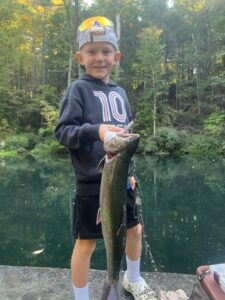
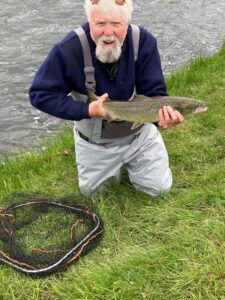
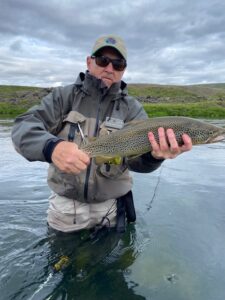
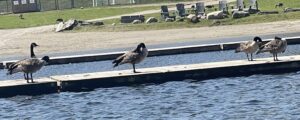
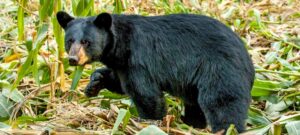
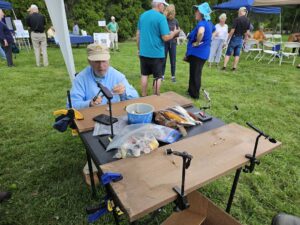
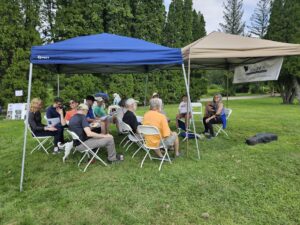
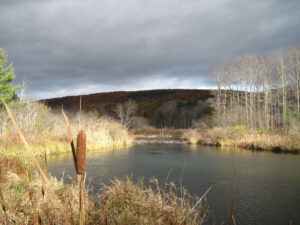


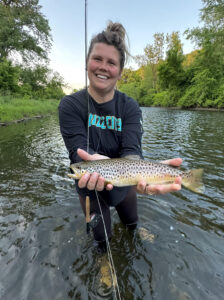
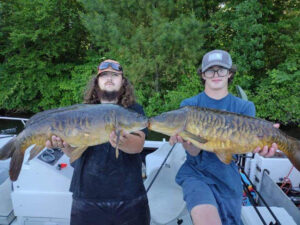
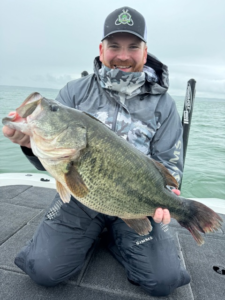 James Bitenbaugh.
James Bitenbaugh.
